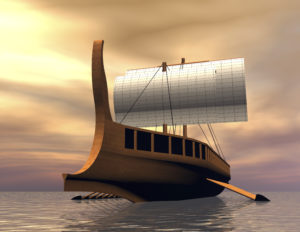In my previous post, Writing Using Visual Thinking as a Starting Point, I indicated that I was working on a book manuscript with the working title, An Explorer’s Guide to Biblical LIfe Planning: Student Version. In this current series of posts I will take you through the story boards that I built to come up with that title. Due to the length and intricacies of these story boards it will take at least five posts to explain my thinking. In this first post I will concentrate on the first phrase in the title, An Explorer. I wanted this first phrase to indicate both the type of individual to whom the book was addressed and the approach to studying the book the reader should take.

I wanted to focus on individuals who, when standing on the edge of a precipice, are willing to look across to the other side and consider whatever crossing avenues are available, no matter how frightened they might be. I wanted to address those individuals who are courageous enough to try to cross that rickety bridge.

I wanted to address those individuals who are willing to use a number of different paths and modes of transportation to achieve their goals. They are willing to do whatever it takes to reach the summit. They aren’t afraid to change mid-stream to a different approach.


I wanted to reach individuals who are willing to search high and low for answers.


I wanted to speak to individuals who are not afraid of books, particularly the Bible. These individuals have an affinity for books and are eager to spend time studying them deeply.


I wanted to speak to individuals who have a deep curiosity about the world and are not afraid to investigate it. They spend time looking carefully at the surface details, but also are brave enough to look beneath the surface.


The individuals to whom I am writing may have a good idea of where God is leading them, but don’t know all of the details. Even with their incomplete information, they are still ready to sail off into stormy waters and unknown seas like Leif Erikson or Christopher Columbus.

More modern versions of brave adventurers of this type include New Zealander Edmund Hillary and Nepalese SherpaTenzing Norgay, who were the first to reach the top of Mount Everest, the highest mountain in the world, at 11:30 a.m. on May 29, 1953. In the intervening years, more than 2000 climbers have reached that peak. However, a number of attempted climbs have ended tragically. More than 200 climbers have died on Mt. Everest’s treacherous slopes. The current year, 2015, is the most costly in terms of human life, with more than 20 climbers perishing as a result of an avalanche in April.

One more recent event than the initial climbing of Mt. Everest that caught the imagination of the world is the moon landings of the American space program. Neil Armstrong and Edwin (“Buzz”) Aldrin, two of the three astronauts in the Apollo 11 space craft, were the first two men to walk on the moon. Since their historical steps, there have been 10 more men to walk on the moon. There could have been two more. However, while en route to the moon, Apollo 13 had serious difficulties. It circled the moon but never landed on it. Almost everyone remembers the famous line from the movie account on this expedition: “Houston, we have a problem!” This is actually a misquote of the line spoken by Apollo 13 commander, Jim Lovell, who really said, “Houston, we’ve had a problem.” Notice the past tense in the Lovell version of the line. The present tense in the movie line makes for a more dramatic moment.

As we look to the future, who can forget the opening lines from the space-based science fiction television series, Star Trek? “Space: the final frontier. These are the voyages of the starship Enterprise. Its five-year mission: to explore strange new worlds, to seek out new life and new civilizations, to boldly go where no man has gone before.” There is the word, I am searching for: explore
.
With all these images floating around in my head, I finally found the word that I needed to use in my title to describe the people to whom I am addressing my book. The one word that fits all of my images is EXPLORER. Hence the opening phrase, “An Explorer’s…” In my next post I will break down the images behind the next word in the title, “Guide“.
Leave a Reply